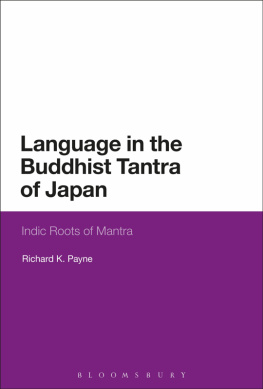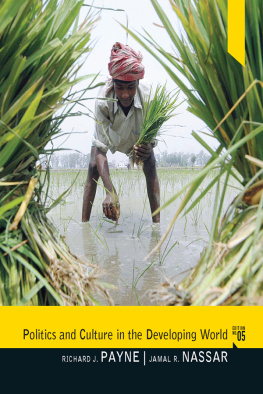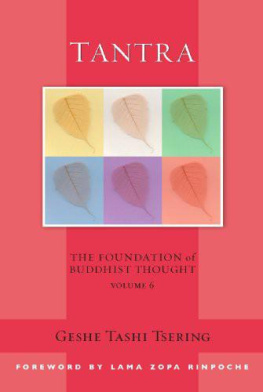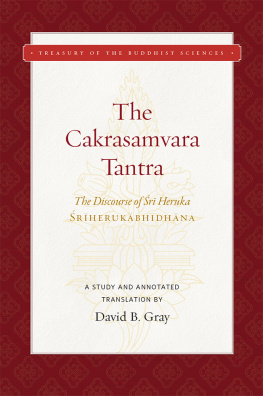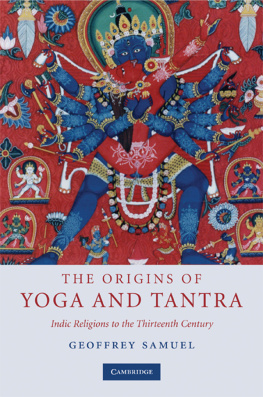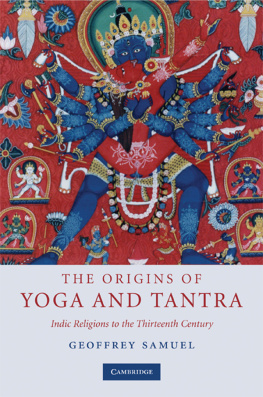Richard K. Payne - Language in the Buddhist tantra of Japan: the Indic roots
Here you can read online Richard K. Payne - Language in the Buddhist tantra of Japan: the Indic roots full text of the book (entire story) in english for free. Download pdf and epub, get meaning, cover and reviews about this ebook. publisher: Bloomsbury UK, genre: Religion. Description of the work, (preface) as well as reviews are available. Best literature library LitArk.com created for fans of good reading and offers a wide selection of genres:
Romance novel
Science fiction
Adventure
Detective
Science
History
Home and family
Prose
Art
Politics
Computer
Non-fiction
Religion
Business
Children
Humor
Choose a favorite category and find really read worthwhile books. Enjoy immersion in the world of imagination, feel the emotions of the characters or learn something new for yourself, make an fascinating discovery.
- Book:Language in the Buddhist tantra of Japan: the Indic roots
- Author:
- Publisher:Bloomsbury UK
- Genre:
- Rating:4 / 5
- Favourites:Add to favourites
- Your mark:
- 80
- 1
- 2
- 3
- 4
- 5
Language in the Buddhist tantra of Japan: the Indic roots: summary, description and annotation
We offer to read an annotation, description, summary or preface (depends on what the author of the book "Language in the Buddhist tantra of Japan: the Indic roots" wrote himself). If you haven't found the necessary information about the book — write in the comments, we will try to find it.
Language in the Buddhist tantra of Japan: the Indic roots — read online for free the complete book (whole text) full work
Below is the text of the book, divided by pages. System saving the place of the last page read, allows you to conveniently read the book "Language in the Buddhist tantra of Japan: the Indic roots" online for free, without having to search again every time where you left off. Put a bookmark, and you can go to the page where you finished reading at any time.
Font size:
Interval:
Bookmark:
Language in the Buddhist
Tantra of Japan
Also available from Bloomsbury
Buddhism and Iconoclasm in East Asia, Fabio Rambelli and Eric Reinders
Buddhism in America, Scott A. Mitchell
A Buddhist Theory of Semiotics, Fabio Rambelli
Language in the Buddhist
Tantra of Japan
Indic Roots of Mantra
Richard K. Payne

To my wife, Bonnie, who has been with me all the steps of this journey.
Provenance of the work
This work draws on materials from several lectures, conference presentations, and publications that began in 1993. In chronological order, these were:
1. Language Conducive to Awakening: Categories of Language Use in East Asian Buddhism began life much more humbly as a response to William Stableins paper The Structure of Extraordinary Sounds and Letters in Buddhist Tantra: The Soteriological Model of the Rite of the Great Black One (Mahkala), presented at the Conference on Extraordinary Language, which was organized by Naomi Janowitz and Martin Schwartz and held at the University of California, Berkeley, on April 30, 1993. It was then extensively revised and expanded, and published in 1998 as the second in the BuddhismusStudien/Buddhist Studies series from Hauses der Japanischen Kultur, Dsseldorf. That monograph is chronologically the earliest publication on the topics discussed in this work.
2. Dhra in the Lotus Sutra was presented on May 47, 2002 at the Lotus Sutra and Asian Culture, Fifth International Lotus Sutra Conference sponsored by the Fritz Thyssen Stiftung, at Marburg Universitt. My thanks to Michael Pye for inviting me to participate in this conference.
3. Ritual Uses of Language was presented in two versions, the first at the Lotus Sutra conference sponsored by Rissho Kosei Kai at Bandaisan, Japan, in August 2001. A revised version was presented at the conference on Language and Discourse in the Transformation of Medieval Japanese Buddhism held at Green Gulch Zen Center in September 2001. My thanks to Gene Reeves for inviting me to participate in the first conference, and to Rissho Kosei Kai for its generous hospitality in hosting that conference. Regarding the second conference, I am deeply grateful to my coorganizer, Taigen Dan Leighton, and the San Francisco Zen Center, which cosponsored the Green Gulch conference along with the Institute of Buddhist Studies (IBS). Aside from my own, papers from this conference, together with those from an American Academy of Religions (AAR) panel (see Item 4 here), were published under the title Discourse and Ideology in Medieval Japanese Buddhism, coedited by Taigen Leighton and me (London and New York: Routledge, 2006). I call this work to the readers attention as including other essays related to the themes of this present work.
4. Awakening and Language: Indic Theories of Language in Japanese Esoteric Buddhism was presented as part of a paper session on Discourse and Rhetoric in Medieval Japanese Buddhism in the Buddhism section at the 2002 AAR conference in Toronto, Canada. I organized this session as a follow-up to the 2001 Green Gulch conference (see Item 3 here), and I wish to express my thanks to the Steering Committee of the Buddhism Section for accepting my proposal and to the other participants in that session.
5. Turning the Wheel of Syllables: Cosmogenesis and Emptiness in Shingon Ritual Praxis was presented at the Thirteenth International Association of Buddhist Studies conference in Bangkok, Thailand, in January 2003. My thanks to Prapod Assavavirunlhakarn for including my presentation in the pair of panels he organized for this conference.
6. Awakening and Language: Indic Theories of Language in Buddhism and Buddhist China was presented at the Faithful/Fateful Encounters: Religion and Cultural Exchanges between Asia and the West conference held in Beijing, 2004, which was jointly sponsored by the Chinese Academy of Sciences and the Graduate Theological Union. My thanks to Judith Berling and Philip Wickeri for including me in this conference.
7. Clear Light Mantra was presented in the session Spells in Buddhism at the AAR conference, November 2023, 2004, in San Antonio. My thanks to the organizers, the other participants, and the respondent.
8. Meaning and Mantra was presented on February 2, 2006, at the University of Oregon, Eugene, under the auspices of the Jeremiah Lecture Series of the Asian and Pacific Studies Center and the Department of Religious Studies. My thanks to Mark Unno and Andrew Goble for inviting me to make this presentation, and to Steve Shankman and the Oregon Humanities Center for supporting the lecture.
9. Authority of the Buddha was presented at The Boundaries of Knowledge in Buddhism, Christianity, and the Natural Sciences conference held at Trinity Lutheran Seminary, Columbus, Ohio, on November 1011, 2006. My thanks to conference organizer Paul Numrich for inviting my participation and to the Templeton Foundation for its sponsorship of the conference.
While the chapters of this work draw on these earlier works, they have been thoroughly rewritten to eliminate redundancies, to expand sections needing greater clarification or additional examples, and to integrate more recent research.
Acknowledgments for Permission to Reprint
is a revised version of The Authority of the Buddha: The Limits of Knowledge in Medieval Indian Buddhist Epistemology, Acta Orientalia Vilnensia 11.1 (2010): 1336.
draws together material from Ajikan: Ritual and Meditation in the Shingon Tradition, in Re-Visioning Kamakura Buddhism, ed. Richard K. Payne (Honolulu: University of Hawaii Press, 1998): 219248, and The Shingon Ajikan: Diagrammatic Analysis of Ritual Syntax, Religion 29 (1999): 215229.
My first expression of appreciation is to Ryichi Ab, who many years ago encouraged me to pursue this project of converting several different conference essays into a coherent work. I hope this fulfills the expectations he had at that time. Also, thanks to Loriliai Biernacki, Sthaneshwar Timalsinha, Ron Davidson, Jacqueline Stone, and Cristina Scherrer-Schaub, for their assistance.
Thanks also to Marianne Dresser who assisted by copyediting all of the earlier versions, and compiling the draft bibliography, so that when I got to revising much of the less than lucid writing had already been untangled. What remains is a consequence of my own overly convoluted thinking.
As always appreciation goes to my friends and colleagues at the IBS, especially Rev. Dr. David Matsumoto, now president, and Dr. Scott Mitchell, now dean. The transitions have not only brought renewed energy to the IBS but also allowed me to invest the time and energy required to bring this work to completion. Direction of the IBS is now in very capable hands, Im pleased to say.
My thanks also to Lalle Pursglove and Lucy Carroll of Bloomsbury for their support and guidance.
My wife, Bonnie, deserves all of the appreciation that I can possibly express for the support and encouragement she has given me over many years and most recently as Ive secluded myself in order to bring this work to completion. And, her willingness to read drafts and talk with me about such abstruse matters is awesome.
Skt. | Sanskrit |
Tib. | Tibetan |
Jpn. | Japanese |
Ch. | Chinese |
T. | Taish shinsh daizky |
P. | Pli |
Ger. | German |
This work brings attention to a particular kind of language use, one that differs from ordinary language use, and which we therefore call extraordinary language use, using extraordinary in the literal sense of outside the ordinary. Despite this, there has been no unifying category allowing recognition, much less discussion of the group as a whole. Like so much in the history of religious traditions, there are no clear boundaries for the category of extraordinary language. It is my contention, however, that this is not a mere artificea category created by the assertion that it existsbut rather a coherent set of practices and beliefs, many of which were mutually influential over the course of three millennia.
Next pageFont size:
Interval:
Bookmark:
Similar books «Language in the Buddhist tantra of Japan: the Indic roots»
Look at similar books to Language in the Buddhist tantra of Japan: the Indic roots. We have selected literature similar in name and meaning in the hope of providing readers with more options to find new, interesting, not yet read works.
Discussion, reviews of the book Language in the Buddhist tantra of Japan: the Indic roots and just readers' own opinions. Leave your comments, write what you think about the work, its meaning or the main characters. Specify what exactly you liked and what you didn't like, and why you think so.

